Rob Stocker, David G Green and David Newth (2001)
Consensus and cohesion in simulated social networks
Journal of Artificial Societies and Social Simulation
vol. 4, no. 4
To cite articles published in the Journal of Artificial Societies and Social Simulation, please reference the above information and include paragraph numbers if necessary
<https://www.jasss.org/4/4/5.html>
Received: 4-Jul-01
Accepted: 30-Sep-01
Published: 31-Oct-01
 Abstract
Abstract
![]() Introduction
Introduction
 Properties of social structures and general
models
Properties of social structures and general
models
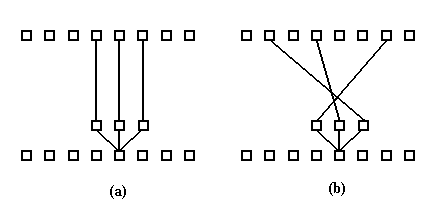
|
| Figure 1: Network wiring: (a) 1-D cellular automata with a neighbourhood of three - all nodes are connected to left, right and centre nodes; (b) 1-D random boolean network - each node is randomly connected to three other nodes to form a pseudo-neighbourhood. |

|
| Figure 2: Visual representations of the structure of (a) random, (b) scale-free (Albert, R et al. 2000) and (c) hierarchical networks. |

|
| Figure 3: Increasing connectivity shown during the formation of a random graph, as edges are added to join pairs of vertices. Notice the formation of groups (connected sub-graphs) that grow and join as new edges are added. |
Cooperation, cohesion and spread of ideas
 Simulation models of social network
structures
Simulation models of social network
structures
 Results
Results
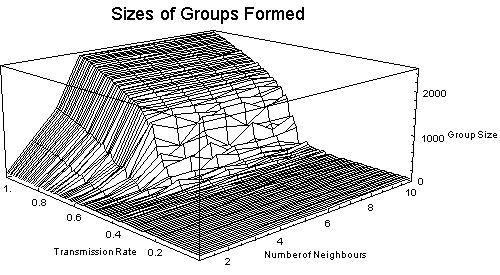
|
| Figure 4: The effects of neighbourhood size and transmission rates on the formation of groups in a simulated landscape (within a universe of 2500 individuals. Average group size dependency on transmission rates and neighbourhood size. |
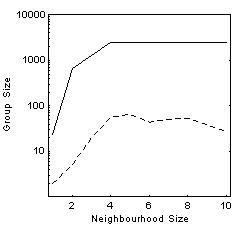 | 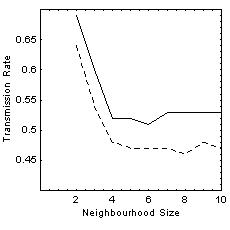
|
| (a) | (b) |
| Figure 5: The effects of neighbourhood size and transmission rates on the formation of groups in a simulated landscape (within a universe of 2500 nodes). (a) Average group size for transmission rates of 1.0 (solid line) and 0.5 (dashed line). (b) Transmission rates required to form a group of over 100 nodes (solid line) and over 30 nodes (dashed line). | |
 | 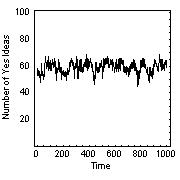 | 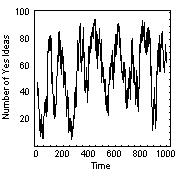
|
| (a) | (b) | (c) |
|
Figure 6: Levels of agreement (number of "yes" ideas) in a simulated society of 100 nodes.
(a) demonstrates rapid polarisation (either complete agreement or disagreement) at 5% connectivity or
above. (b) shows oscillatory behaviour at less than 3.0% connectivity. (c) demonstrates the region
of critical behaviour for connectivity levels of 3.0 to 4.0%.
All nodes assigned a fixed level of influence (0.1, 0.25, 0.5, 0.75,1.0) | ||
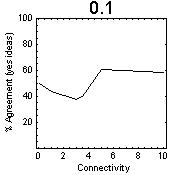 | 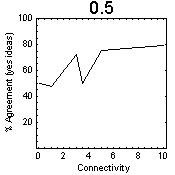 | 
|
| (a) | (b) | (c) |
| Figure 7: Effects of fixed levels of influence assigned to each node in the population showing critical behaviour at 3.0 to 5.0% connectivity (average number of connections per node as a percentage of the population), and change in agreement after the region of critical connectivity. One node at a specific position with high level of influence (1.0) | ||
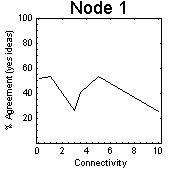 | 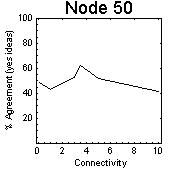 | 
|
| (a) | (b) | (c) |
| Figure 8 (a-c): Effects of varying the position of a node (with maximum influence) on agreement in the population, showing the region of criticality occurring between 1.0% and 5.0% connectivity. | ||

|
| Figure 9: The effects of increases in connectivity for population sizes of 1000 (dashed line) and 100 (solid line), on the percentage of nodes in the population that changed state to consensus. |
 Discussion
Discussion
BAK, P and BRUISMA, R (1982), One-dimensional Ising model and the complete devil's staircase. Phys. Rev. 49: 249-251.
BARRAT, A and WEIGT, M (2000),. On the properties of small-world network models. Eur. Phys. J. B. 13: 547-560.
BOLLOBÁS, B (1985), Random Graphs. New York: Academic Press.
BURT, R S (1982), Social contagion and innovation: Cohesion versus structural equivalence. American Journal of Sociology. 88: 1287-1335.
CAMPBELL, J (1984), Grammatical man - information, entropy, language and life: The story of the modern revolution in human thought. Middlesex, England: Penguin Books Ltd.
CONTE, R HEGSELMANN, R and TERNA, P (1997) Introduction: Social simulation - A new disciplinary synthesis. In Conte, R et al. (Eds) Simulating social phenomena. Heidelberg: Springer-Verlag: 1-17.
DUNBAR, R I M (1992), Neocortex size as a constraint on group size in primates. Journal of human evolution. 20: 469-493.
DUNBAR, R I M (1995), Neocortex size and group size in primates: a test of the hypothesis. Journal of human evolution. 28: 287-296.
DUNBAR, Robin (1996), Grooming, Gossip and the Evolution of Language. London: Faber and Faber.
ERDÖS, P and RÉNVI, A (1960), On the evolution of random graphs. Mat. Kutato. Int. Kozl. 5: 17-61.
FEYNMAN, R P (1996), Feynman Lectures on Computation. Perseus Books.
FURMAN, M E and GALLO, F P (2000), The neurophysics of human behaviour. London: CRC Press.
GILBERT, N and TROITZSCH, K G (1999), Simulation for the social scientist, , Buckingham, UK: Open University Press.
GLADWELL, M (1999), The tipping point, London: Little Brown.
GREEN, D G (1993), Emergent behaviour in biological systems. In Green, D G and Bossomaier, T R J (Eds) Complex Systems - From Biology to Computation, Amsterdam: IOS Press: 24-35.
GREFENSTETTE, J J (1983), Network structure and the firing squad synchronization. Journal of computer and system sciences. 26: 139- 152.
HANNEMAN, R A (1995), Simulation modelling and theoretical analysis in sociology. Sociological Perspectives. 38 (4): 457-462.
HARVEY, I and BOSSOMAIER, T R J (1997), Time out of joint: Attractors in asynchronous boolean networks. In P Husbands and I Harvey (Eds) Proc. Fourth European Conference on Artificial Life: 67-75.
HEISENBERG, W (1928), "Zur Theorie des Ferromagnetismus." Zeitschr. f. Physik.49: 619-636.
HOGEWEG, P and HESPER, B (1983), The ontogeny of the interaction structure in bumblebee colonies: a MIRROR model. Behav. Ecol. Sociobiol. 12: 271-283.
ISING, E (1925) "Beitrag zur Theorie des Ferromagnetismus." Zeitschr.. f. Physik.31: 253-258.
IWANAGA, S and NAMATAME, A (1999), Evolutionary properties of collective decisions. In McKay, et al. (Eds) Proceedings of the third Joint Australia-Japan Workshop on Intelligent and Evolutionary Systems (AJJWIES). Canberra, Australia: 175-182.
JEONG, H, TOMBOR, B, ALBERT, R, OLTAVI Z N and BARÃBASI, A-L (2000), The large-scale organisation of metabolic networks. Nature. 407: 651-654.
KAUFFMAN, S A (1992), The Origins of order: Self- organization and selection in evolution, Oxford: Oxford University Press.
KLÜVER, J and SCHMIDT, J (1999), Topology, Metric and dynamics of social systems. Journal of Artificial Societies and Social Simulation. 2: 3.
KUBO, M, KUROKI, S, SATOH, H, MIKAMII, S, NAMATAME, A and WADA M (1999), Prediction based agent promotes cooperative behaviour. In McKay, et al. (Eds) Proceedings of the third Joint Australia-Japan Workshop on intelligent and evolutionary systems (AJJWIES). Canberra, Australia: 1- 7.
LIEBRAND, Wim B G (1998) Computer modelling and the analysis of complex human behaviour: Retrospect and prospect. In Liebrand, et al. (Eds) Computer Modelling of Social Processes: New Technologies for Social Research. London: Sage Publications: 1-19.
MACY, M W (1998), Social order in artificial worlds. Journal of Artificial Societies and Social Simulation. 1: 1.
MARSDEN, P (2000), Mental epidemics. New Scientist, 2237: 46-47.
MEAD, C and CONWAY, L (1980), Introduction to VLSI systems, Reading Mass: Addison-Wesley.
NOWAK, Andrzej and LEWENSTEIN, Maciej (1996), Modelling social change with cellular automata. Hegselmann, R (Eds) Modelling and simulation in the social sciences from the philosophy of science point of view. 249-285 Netherlands: Kluwer Academic Publishers.
PEIERLS, R (1936), "On Ising's Model of Ferromagnetism." Proc. Cambridge Phil. Soc. 32: 477-481.
POTTS, R B (1952), Some generalized order-disorder transformations. Proc. Camb. Phil. Soc. 48: 106.
SCOTT, J (1991) Social network analysis: A handbook, London: Sage Publications.
STAUFFER, D (1979), Percolation. Physics Reports, 54: 1-74.
TROITZSCH, Klaus G (1997) Social science simulation - Origins, prospects, purposes. In Conte, R et al. (Eds) Simulating social phenomena. Heidelberg: Springer-Verlag: 40-54.
TROITZSCH, Klaus G (1998) Multilevel process in the social sciences: Mathematical analysis and computer simulation. In Liebrand, et al. (Eds) Computer Modelling of Social Processes: New Technologies for Social Research. London: Sage Publications: 20-36.
UNO, K, SATO, H and NAMATAME, A (1999), Social evolution with imitation. In McKay, et al. (Eds) Proceedings of the third Joint Australia-Japan Workshop on Intelligent and Evolutionary Systems (AJJWIES). Canberra, Australia: 33- 40.
WASSERMAN, S and FAUST, K (1995), Social network analysis: Methods and applications. Cambridge, Cambridge University Press.
WATTS, D J and STROGATZ, S H (1998), Collective dynamics of 'small world' networks. Nature 393: 440.
WELLMAN, B and BERKOWITZ, S D (1998), Introduction: studying social structures. In Wellman, B and Berkowitz S D (Eds), Social structures: A network approach, Cambridge: Cambridge University Press: 1-18.
WELLMAN, B CARRINGTON, P J and HALL, A (1998), Networks as personal communities. In Wellman, B and Berkowitz S D (Eds), Social structures: A network approach, Cambridge: Cambridge University Press: 130-184.
WUENSCHE, Andrew (1998), Discrete dynamical networks and their attractor basins. In Standish, et al. (Eds) Complex systems '98, Complexity between the ecos: From ecology to economics. Sydney, Australia: 3-21.
![]()
Return to
Contents
of this issue
© Copyright Journal of Artificial Societies and Social Simulation, 2001